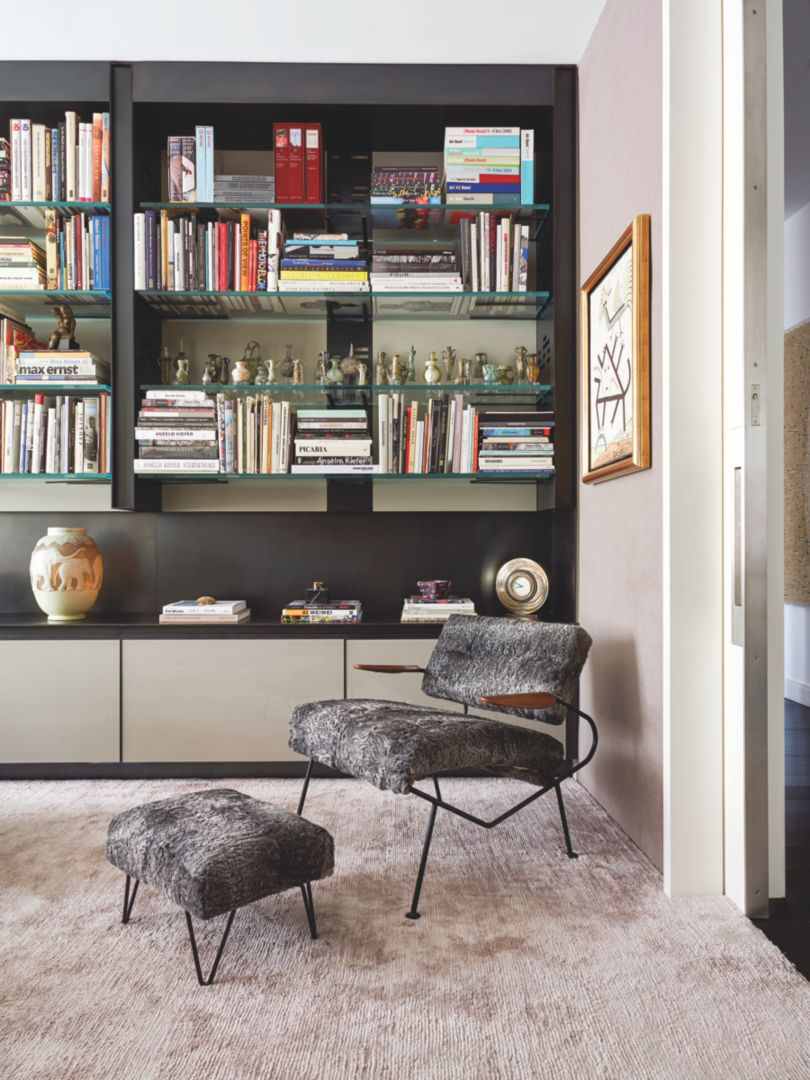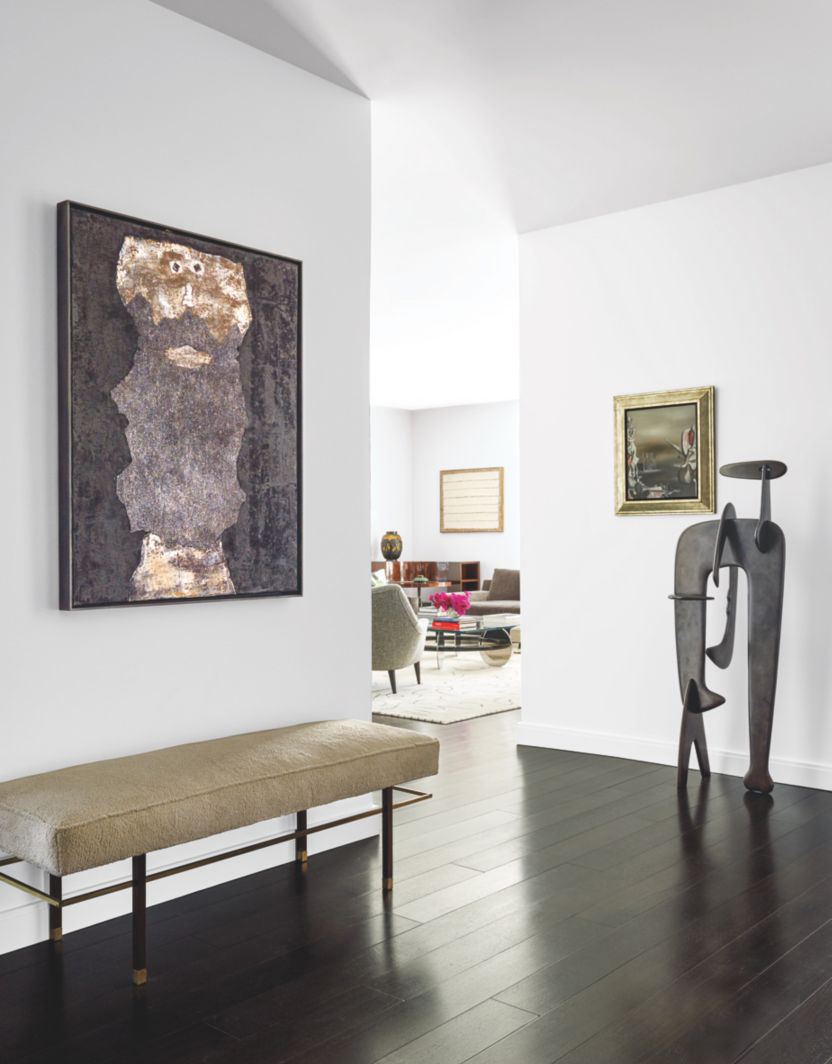Luxe Interior + Design
Artful Living
This is a story about love and passion and art, inextricably woven together. For most of their 37- year marriage, a couple have lived in a co-op in a classic prewar building on the Upper East Side, which “has aged with history and elegance,” the wife says. They bonded over art (both of their parents also were collectors), married, had two children, and continued to collect together, even though they admittedly had different sensibilities.
Most of the couple’s postwar art, including Dubuffet, Marini and Noguchi, was acquired during the past 30 years from galleries, auctions and private collections. But the past three years have been more devoted to contemporary pieces, such as Baselitz, Kiefer, Bourgeois, Chillida, Sterling Ruby, and artists of the Korean Dansaekhwa movement, including Kim Whanki and Lee Ufan. That was a turning point. “That’s when we decided that the apartment was to be renovated,” the wife says. “Homes need to be reinvented, just like wardrobes. In this case, the need was to become more contemporary.”
For interior designer Nina Wexler, rebooting the four- bedroom 6,100-square-foot apartment to a more minimal style was the perfect job. “My philosophy always has been ‘less is more,’ ” she says. “To me, a home should not only reflect the values of the people who live there, but it should serve as a backdrop to the personalities that embody it.” Throughout, the vibe is calming. “Life is hectic,” the wife says. “So, the need for calm and serenity inside our home was a priority.”
Without altering the layout, Wexler worked with longtime friend and architect Mark Stumer, as well as general contractor Vincent DiSalvo, to modernize the interiors, creating spaces that would allow current and future art to breathe and be celebrated. “We wanted to create a loft-like feeling,” Wexler explains. Respecting the apartment’s great bones, they began to edit. Most of the moldings were stripped and replaced, and door widths were beefed up to 7 feet and heights raised to 9 1⁄2 feet. In addition, vaulted ceilings were eliminated.
Other cosmetic do-overs instantly shifted the tone. In the living room, Stumer says, “the original replace mantel was more detailed, higher in the wall, more of a statement piece.”
In its place now is a minimal surround in pristine white onyx, so as not to draw attention from the starring art. Likewise, the media room replace is nearly invisible—a slot in a blackened-steel surround, centered below an op-art light sculpture. Other thoughtful alterations include changes in window pockets, removing moldings so everything is flush. “It’s a much more contemporary look,” Stumer says.
New lighting is perhaps the most significant installation, an elaborate fiber-optic system con figured to adapt to rearranging art that required removal of the entire ceiling. “The lighting is pure white,” Stumer says, “most of it specific to the art. We didn’t need to be worried about lining up heads. It’s not a symmetrical design.” Wexler also specified plenty of table and floor lamps throughout the layout. “Lighting is so important to a home, with different layers,” she says. “It’s another way to add warmth, embrace a room.”
With a revolving art collection, the designer knew it was essential for the palette to stay neutral. From soft off- white to greige, the range is soothing, enhanced by tactile, sensual play with textiles such as bouclé, leather and Mongolian lamb. There are mohair- and suede-clad walls “for richness and character,” Wexler says, and lacquers for “dimension and luster.”
Furnishings are commodious, designed with entertaining in mind. “Prior to the renovation,” the wife says, “there were several seating areas in the living room. But guests tend to congregate together, so we did a central seating zone.” Two 8-foot sofas, a pair of chairs and an upholstered bench are arranged conversationally around a custom glass-steel-and- wood table set on what Wexler describes as a whimsically patterned rug.
Nearby, the nearly 23-by-19-foot dining room is purposely low-key. But during meal time, the room comes to life—with the table set, flowers and guests enjoying each other’s company. “It’s warm and beautiful,” Wexler says. In the media room, lacquered cabinetry organizes books and offers closed storage in symmetry. One of the few bold colors in furnishings is a vivid blue lacquered cocktail table Wexler designed; it takes cues from the art.
Stumer says a 1950s French industrial look inspired the library’s built-in lacquer-and-painted-glass cabinetry, with raised slots that create patterns at metal sides to hold glass shelves. A circa-1925 Emile-Jacques Ruhlmann desk is a centerpiece, part of the couple’s Art Deco collection. “Great Art Deco goes with everything,” Wexler says. The mix of styles is just what the clients desired. “They didn’t want to get stuck in any particular genre, which is why the apartment is timeless,” Wexler says. “It’s contemporary, with an eclectic mix of period pieces that serves to anchor every room.”
Regarding the art, there are still some issues on which the couple still agree to disagree. “He feels art speaks for itself and can be anywhere,” Wexler says. “She feels that there needs to be a conversation to make sense.” And even though it’s tough for them to let go of one piece when a new one comes in, the designer points out a distinct advantage: “It’s like a vacation for your eyes,” she says. “You can travel around the world without leaving home.”















